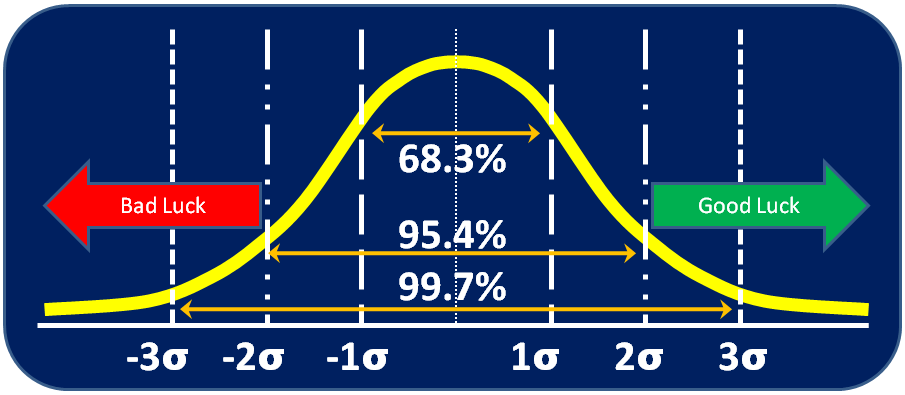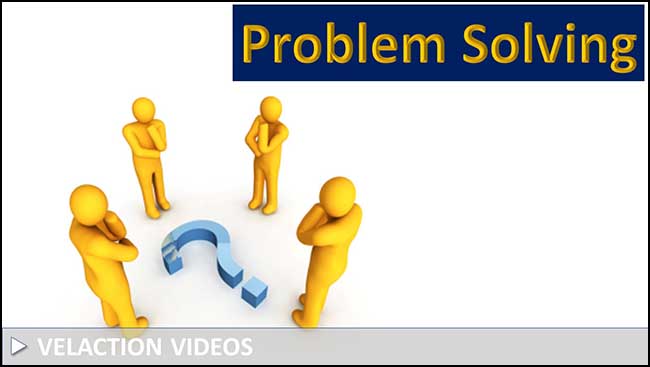Luck
Luck is the combination of events and circumstances that randomly impact an outcome. The more one can control those inputs, the more likely the result is to be a desired one.
In a trip to Las Vegas, an individual has little impact on the outcome of games of chance. Roulette wheels and slot machines and dice don’t care whether you rub your hands together, shout “No Whammies”, or blow on the dice. You have no influence on the result. All you can do is decide how to bet.
In blackjack, though, you can slow down the pace of the poor outcome with skill. You are able to make some decisions along the way. At the start of every game, though, the odds are still stacked in favor of the house.
In poker, though, you have a fighting chance. You are competing with other individuals, not the laws of physics. If you have knowledge and talent, you can control the inputs to the equation, and have a chance of winning.
One of the goal of continuous improvement is to control those inputs to give yourself an increased chance of winning.

Luck plays a role in business, but you can improve your odds.
Imagine you are an aspiring actor or actress or musician in Hollywood and want your big break. Are you more likely to get it working in a small diner off the beaten path, or working where the entertainment industry’s decision makers are likely to be?
If you have a job interview, do you leave the results entirely to chance, or do you make sure your résumé is polished, your shirt is pressed, you’ve gotten a good night’s sleep, you’ve avoided anything that could spill on your clothes, and you’ve studied the company in detail? If you do all that, you improve your chances. You can’t control whether the interviewer just had a fight with her boss and is in a bad mood, or if he is facing a crisis on the shop floor and is inattentive. Likewise, no matter how much you do, there will always be an element of chance in any process in the workplace.
Your job in continuous improvement, though, and the main focus of Six Sigma in particular, is to remove the sources of the variation that causes waste.
If you are familiar with the concept of a normal distribution, you will know that there are tails on each end of the curve. These tails are the good luck and bad luck areas. The further we get from the center of the curve, the more we attribute the results to luck.
What many people forget, though, is that we can control the shape of the curve. Six Sigma aims to squeeze the curve to make it narrower. In effect, you want more of the curve to fit into what you call normal outcomes. You want to take luck out of the equation.
Lean, without saying it so directly, does the same thing. It uses Standard Work to take luck related to how a process is done out of the system. It uses kanban cards to take luck related to material deliveries out of the system. It uses TPM to take bad breaks from machine failures out of the system.
In short, with good continuous improvement systems, you go a step further than making your own luck. You take luck out of the system to such a degree that any of the randomness is within the range of what you would call a good outcome.
![]()
Play a sample…

Words of Warning
- Decide what an acceptable risk is when betting your resources. The level of effort in eliminating that risk increases as the certainty you require goes up.
- You control far more than you think you do. For example, you can choose local suppliers to take transit risk out of your equation or you can place a factory in an area with no natural disasters. Look for the root causes of the apparent randomness and you may find a controllable factor.

You are the first line of defense against relying on luck in a process. When you identify something that requires a roll of the dice, you’ve found a good opportunity. Examples would be a part that is scratched about 10% of the time, or a critical piece of information that is frequently missing from an order form. Make sure you don’t just accept those situations as the luck of the draw. Record the failures and report them to your boss. Or better yet, if you have an empowered continuous improvement culture, work with your team to resolve the problem.

Never accept that luck has to be part of a process. Acknowledge that you can control the factors that make luck. You may not get to them all but make it an active decision not to work on something rather than a passive belief that you can’t do anything about a problem. Once you change your mindset about how you approach randomness in your process, you will open up many new opportunities.

Key Points About Relying on Luck
- Luck is not an effective method of production. Eventually, bad luck will catch up to you if you rely heavily on chance for good outcomes.
- You control more of your luck than you think.
![]()
Select an area where you think luck plays a prominent role. Do a cause and effect diagram to get a better understanding of the causes, and then dive deeper into the major problems with the 5 Whys tool. The goal is to understand the main factors that affect the variation, and then act to control them.




0 Comments